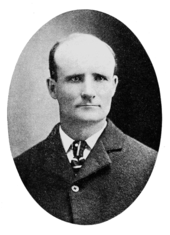John Bell Hatcher
John Bell Hatcher (born October 11, 1861 in Cooperstown (Illinois) , † July 3, 1904 in Pittsburgh ) was an American paleontologist .
He grew up in Cooper , Iowa, earned the money to study as a miner in coal mining and studied from 1880 at Grinnell College and from 1881 at Yale University (Sheffield Scientific School) with the degree in 1884. He was then an assistant to the paleontologist Othniel Charles Marsh and collected fossils for this in the western United States. At first von Marsh was assigned as an assistant to the paleontologist Charles H. Sternberg , but soon afterwards worked independently in Kansas , in the Permian of Texas and from 1886 to 1888 in the Oligocene of Nebraska and South Dakota , from where he transferred over seven tons of Titanotherium fossils to the Peabody Museum sent. In 1889 he found a fossil skeleton of the Torosaurus near Lusk (Wyoming) , as well as the skulls of 33 other Ceratopsians in the following four years. He was dissatisfied with his position at Marsh (assistants were not allowed to publish there, and the first description of Torosaurus was done by Marsh).
He negotiated unsuccessfully with Henry Fairfield Osborn of the American Museum of Natural History from 1890 and went to Princeton University in 1893 as curator of vertebrate paleontology and assistant in geology. He collected first in the Oligocene of South Dakota, Miocene and Pleistocene of Nebraska and in the Cretaceous of Wyoming. From 1896 to 1899 he went on expeditions to excavations in Patagonia . He organized the financing largely himself and returned with numerous fossils of mammals from the Miocene. He was accompanied by the paleontologist Olaf Peterson , with whom he was related by marriage. With financial help from Andrew Carnegie , he published several volumes of monographs on the expedition. From the similarity of the fossil fauna he developed the hypothesis that South America, Australia and the Antarctic used to form a land mass and wanted to test this in the Antarctic, but this no longer happened.
In 1900 he became a curator for paleontology and osteology at the Carnegie Museum of Natural History . There he was responsible for the investigation and installation of a Diplodocus skeleton (called "Dippy") and published a monograph on this in 1901 (he named the species Diplodocus carnegii after the museum's sponsor Andrew Carnegie). He also oversaw the reconstruction of specimens that went to London (1905) and Berlin. Before he died of typhoid fever, he was working on completing a monograph on Ceratopsier that Marsh had begun - it was completed in 1907 by Richard Swann Lull .
He is the first to describe Teleoceras . He also developed a method to search for the tiny fossil remains of mammals from the Mesozoic, such as teeth and jaws in anthills, and in some cases he also implanted ant colonies in promising search areas. In 1897 he was elected a member of the American Philosophical Society .
He had been married since 1887 and had four children. His grave in Pittsburgh was originally unmarked but was fixed in 1995 (with a Torosaurus image on the headstone).
literature
- Tom Rea: Bone Wars: The Excavation and Celebrity of Andrew Carnegie's Dinosaur, Pittsburgh University Press 2001
Web links
Individual evidence
- ↑ Justin Tweet, Mesozoic Mammals, National Park Service, National Fossil Day 2014
- ^ Member History: John B. Hatcher. American Philosophical Society, accessed September 24, 2018 .
| personal data | |
|---|---|
| SURNAME | Hatcher, John Bell |
| BRIEF DESCRIPTION | American paleontologist |
| DATE OF BIRTH | October 11, 1861 |
| PLACE OF BIRTH | Cooperstown , Illinois |
| DATE OF DEATH | July 3, 1904 |
| Place of death | Pittsburgh |
